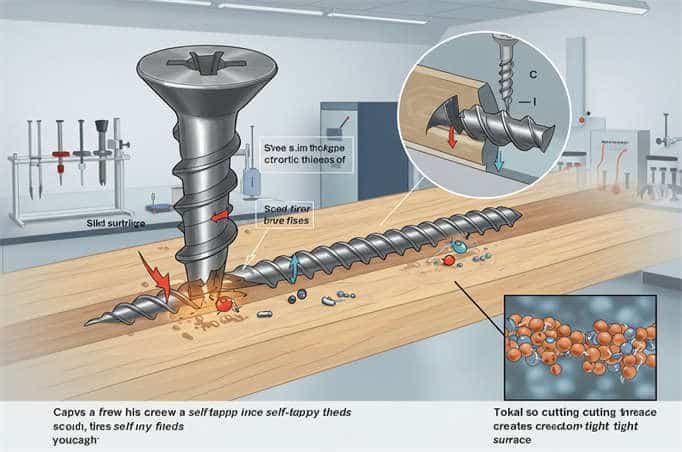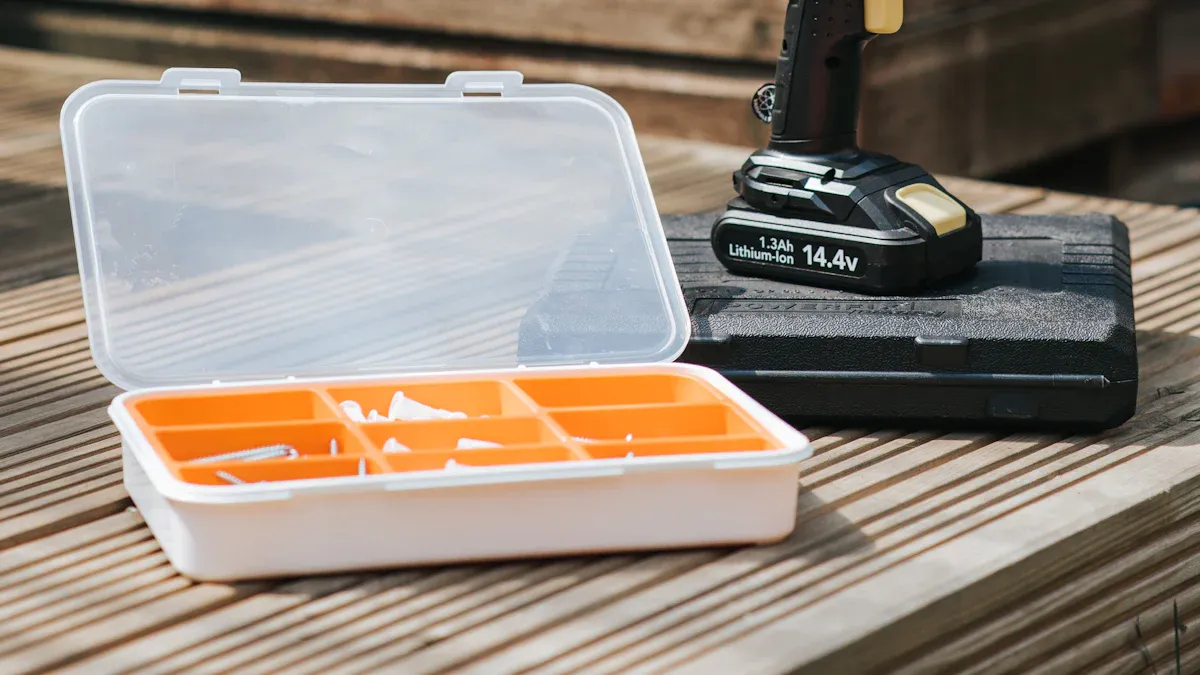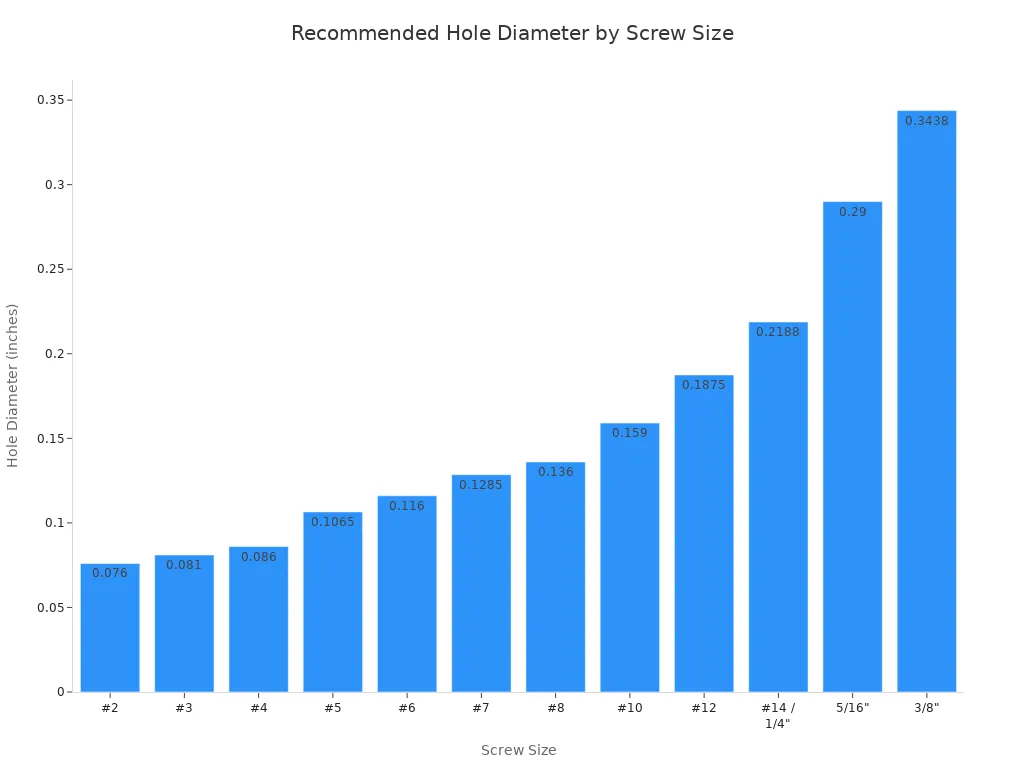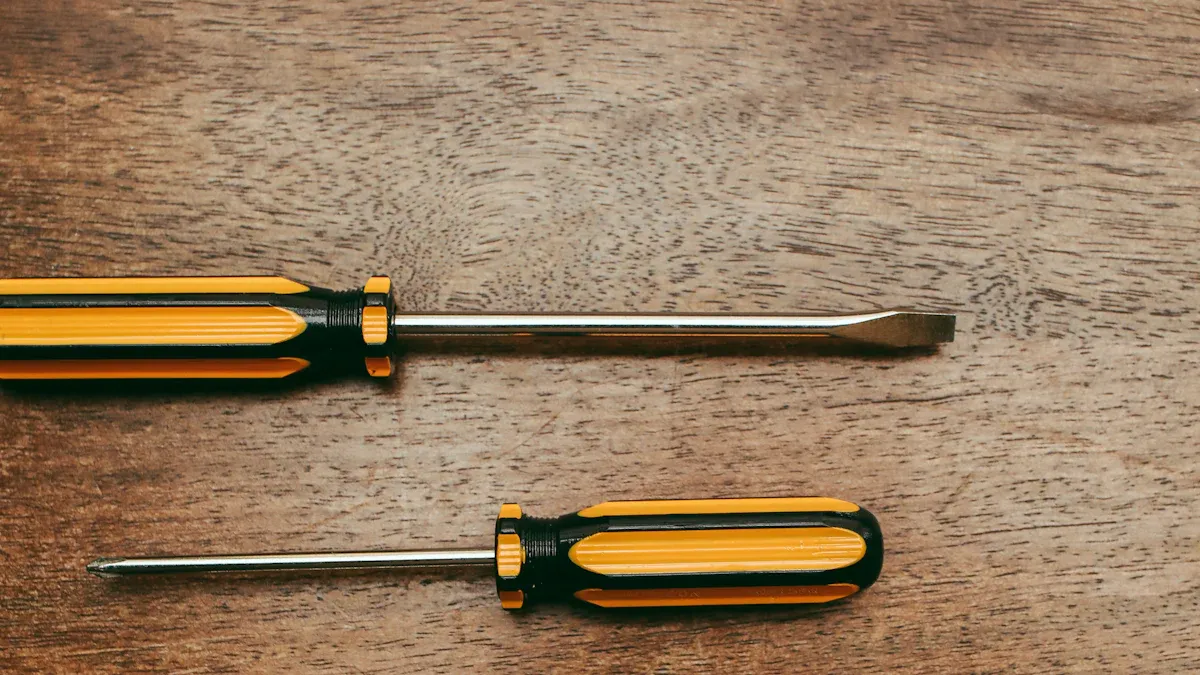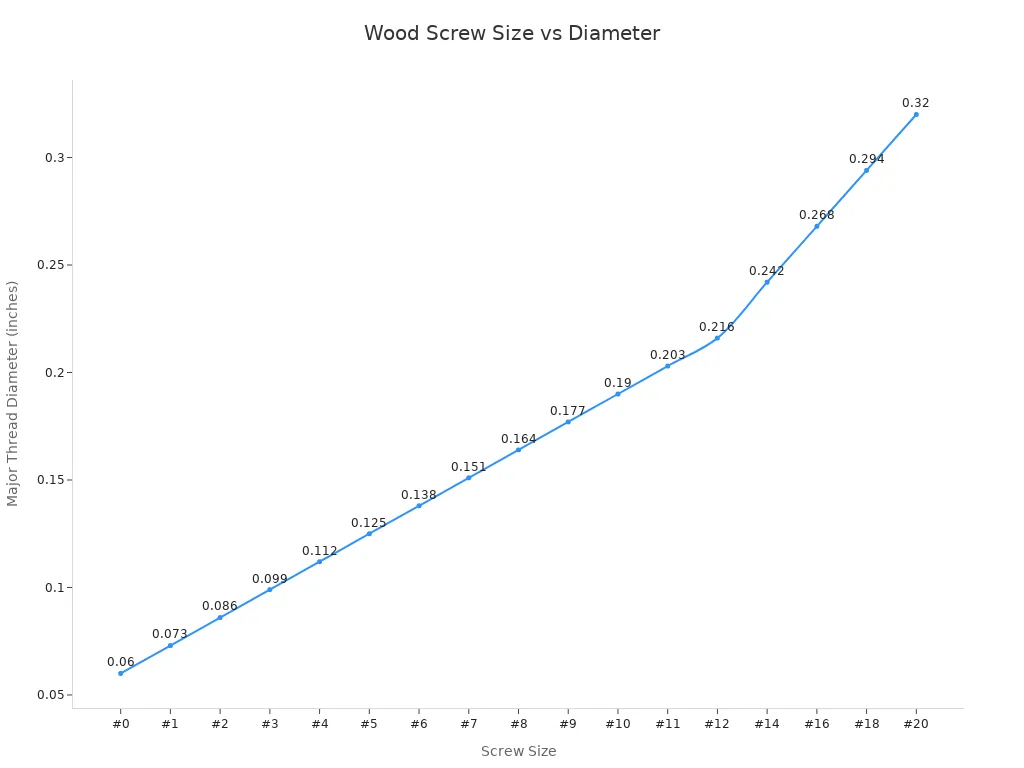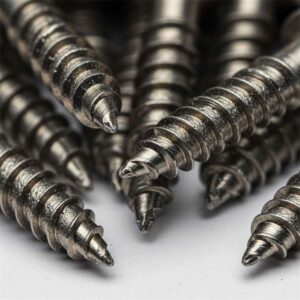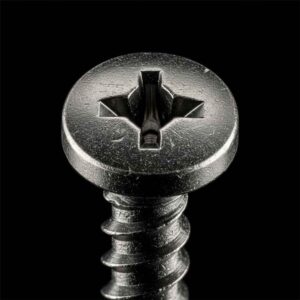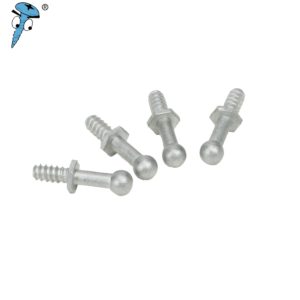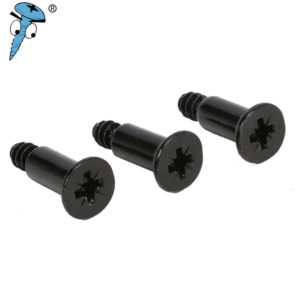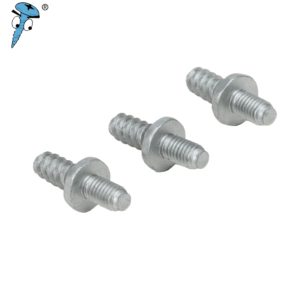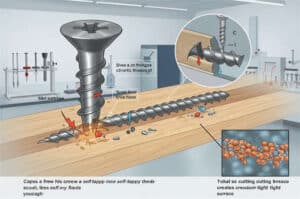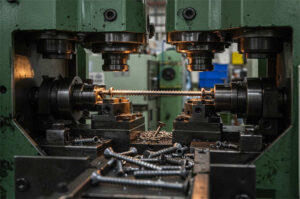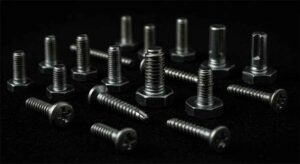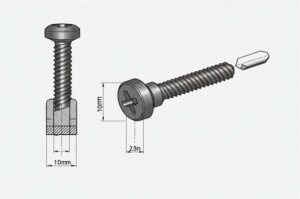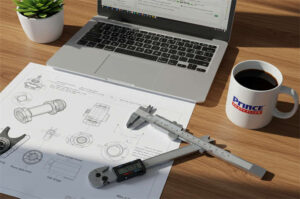For most users, you should choose a wood screw diameter chart that gives clear size information and is easy to read. You need accuracy when picking wood screws for any project. The right screw can help your work last longer. Always match the chart to your project type and your skill level.
Principales conclusiones
- Pick a wood screw diameter chart that is simple to read. This makes it easier to pick the right screws for your work.
- Find charts that show screw sizes, lengths, diameters, and drill bit sizes. This helps you get all the details you need to choose screws correctly.
- Think about your project and how much you know when picking a chart. Beginners may like charts with pictures. People with more experience may want charts with more details.
Wood screw diameter chart comparison
Top chart features
When you choose a wood screw diameter chart, you want one that gives you all the details you need for your project. The best charts show screw sizes, lengths, diameters, drill bit sizes, and head types. You can see these features in the most recommended charts, such as McFeely’s and The Ultimate Screw Size Guide. These charts help you pick the right screw for your material and project.
Here is a table that shows what you can expect from leading wood screw diameter charts:
| Chart Name | Screw Sizes | Lengths | Diameters | Drill Bit Sizes | Head Types | Decimal & Fractional | Material Guidance | |—————————|————-|———|———–|—————–|————|———————| | McFeely’s | Yes | Yes | Yes | Yes | Yes | Yes | Yes | | The Ultimate Screw Size Guide | Yes | Yes | Yes | Yes | Yes | Yes | Yes | | Standard Infographic | Yes | Yes | Yes | Sometimes | Sometimes | Sometimes | Sometimes |
You can see that McFeely’s and The Ultimate Screw Size Guide both offer a full range of information. These charts include screw sizes, lengths, and diameters. They also show you which drill bit to use and what head type fits your needs. Some charts even give you both decimal and fractional measurements, which makes it easier to match your tools.
The most valued features in these charts include:
- Clear display of screw type and size.
- Easy-to-read tables for quick reference.
- Guidance for matching screws to wood or other materials.
- Information about the gauge of a screw, which tells you how thick the screw is.
You can use the following table to compare US and metric measurements for wood screw diameter. This helps you work with both systems:
| US (Inches) | Metric (mm) |
|---|---|
| 1/16″ | 1.59 mm |
| 1/8″ | 3.18 mm |
| 3/16″ | 4.76 mm |
| 1/4″ | 6.35 mm |
| 5/16″ | 7.94 mm |
| 3/8″ | 9.53 mm |
| 7/16″ | 11.11 mm |
| 1/2″ | 12.70 mm |
| 9/16″ | 14.29 mm |
| 5/8″ | 15.88 mm |
| 11/16″ | 17.46 mm |
| 3/4″ | 19.05 mm |
| 7/8″ | 22.23 mm |
| 1″ | 25.40 mm |
| 1-1/4″ | 31.75 mm |
You will notice that a higher gauge number means a thicker screw. For example, a #6 screw is 0.138 inches wide, while a #10 screw is 0.190 inches wide. This difference matters when you work with different materials.
Visual vs. tabular guides
You can find wood screw diameter charts in both visual and tabular formats. Each style has its own strengths. Visual guides use images, diagrams, or infographics. These help you see the size and shape of wood screws at a glance. Tabular guides use tables to organize information. You can quickly look up the screw size, diameter, and recommended drill bit.
Here is a sample table from a detailed screw chart:
| Tamaño del tornillo | Screw Threads per Inch | Diámetro de orificio recomendado | Tamaño de broca |
|---|---|---|---|
| #2 | 32 | 0.0760″ | #48 |
| #3 | 28 | 0.0810″ | #46 |
| #4 | 24 | 0.0860″ | #44 |
| #5 | 20 | 0.1065″ | #36 |
| #6 | 18 | 0.1160″ | #32 |
| #7 | 16 | 0.1285″ | #30 |
| #8 | 15 | 0.1360″ | #29 |
| #10 | 12 | 0.1590″ | #21 |
| #12 | 11 | 0.1875″ | 3/16″ |
| #14 / 1/4″ | 10 | 0.2188″ | 7/32″ |
| 5/16″ | 9 | 0.2900″ | L |
| 3/8″ | 9 | 0.3438″ | 11/32″ |
You can also use visual charts, like this bar chart, to compare recommended hole diameters for each wood screw size:
Tabular guides work best when you need to find information fast. You can scan the table and get the answer right away. Visual guides help you understand the relationship between screw sizes and their uses. You might prefer one style over the other, or you might use both together.
Tip: Use a tabular guide for accuracy and a visual guide for quick checks. This way, you get the best of both worlds.
When you select a wood screw diameter chart, think about your project and your experience. If you are new to woodworking, a visual guide can help you learn. If you work on many projects, a detailed table will save you time. Both types of guides help you choose the right wood screws and avoid mistakes.
Reviews of wood screw diameter guides
McFeely’s screw size chart
Many people use McFeely’s screw size chart in their workshops. This chart shows wood screw diameter, length, and which drill bit to use. You can match wood screws to your project with it. The chart has both decimal and fractional measurements. This helps you use different tools. It also lists head diameters and gives advice for certain materials.
Strengths:
- You can find many screw sizes and types.
- The chart lists both US and metric measurements.
- It is easy to find the right screw hole size.
- Many people trust this chart for being correct.
Weaknesses:
- Some people say McFeely’s screw shanks are bigger than they thought. This can be a problem if you need a perfect fit.
- The #8 screws sometimes break when you put them in. About 1 out of 20 people have this problem.
- The #10 screws have a thicker shank and hold better. You should check if they fit your material.
Ideal use cases:
- You want a chart you can trust for most woodworking jobs.
- You need to compare wood screw diameter for different sizes.
- You use both imperial and metric systems.
Tip: If you want strong holding power, pick #10 screws instead of #8 screws. Many people say #10 screws work better than nails for tough jobs.
Guía definitiva de tamaños de tornillos
Guía definitiva de tamaños de tornillos gives you lots of details. You see screw sizes in both imperial and metric units. The guide explains screw dimensions and what they are used for. It also gives advice for different materials. You can pick the best wood screws for wood, metal, or drywall.
| Característica | Guía definitiva de tamaños de tornillos | Standard Wood Screw Diameter Charts |
|---|---|---|
| Overview of screw sizes (imperial & metric) | ✔️ | Limitado |
| Detailed explanations of dimensions & uses | ✔️ | Often missing |
| Material-specific recommendations | ✔️ | General only |
| Practical tips for screw selection | ✔️ | Mínimo |
You will see both decimal and fractional measurements in this guide. The chart lists head diameters and gives advice for different materials. You can use the guide to learn about screw selection and avoid mistakes.
Strengths:
- You get clear explanations for each screw type.
- The guide helps you pick the right screw for your material.
- You can use it for many projects, not just woodworking.
Weaknesses:
- The guide might feel like too much if you only want simple info.
- You may spend more time reading all the details.
Ideal use cases:
- You want to learn more about wood screws and how to use them.
- You need to match screws to special materials.
- You like a guide with extra tips and advice.
Infographic and app-based guides
Infographic and app-based guides make learning about wood screw diameter easy. You see colorful layouts and quick visual hints. These guides help you understand screw sizes and uses fast. Many apps let you search for screw hole sizes or compare wood screws side by side.
| Advantage | Infographic/App-Based Guides | Traditional Printed Charts |
|---|---|---|
| Engagement | Colorful and dynamic | Static |
| Understanding | Quick visual cues | Slower to read |
| Versatilidad | Covers many topics | Limited scope |
| Accessibility | Easy to share and view | Harder to access digitally |
| Learning Styles | Fits many styles | Fewer options |
You can use infographic guides if you like to learn by seeing. App-based guides are good if you want info on your phone or tablet. Some apps let you enter your project details and get screw suggestions.
Strengths:
- You get quick answers with easy visuals.
- The guides work for many learning styles.
- You can use them anywhere, even at a job site.
Weaknesses:
- Some guides do not show all screw details, like head diameters.
- You might need internet for some app features.
Ideal use cases:
- You want fast checks while working.
- You like learning with pictures or interactive tools.
- You need a guide you can take anywhere.
Note: Infographic and app-based guides help you learn about wood screw diameter and screw selection fast. Use them for quick reference, but check a detailed chart if you need exact measurements.
Choosing the right wood screw chart
Selection checklist
When you pick a wood screw chart, you want to make sure it covers all the important details. Use this table to check if your chart includes what you need:
| Criteria | Descripción |
|---|---|
| Head size | Shows what kind of driver fits the screw. |
| Diámetro | Tells you the shaft width for strength and fit. |
| Longitud | Explains how deep the screw can anchor into your material. |
| Paso de rosca | Shows the distance between threads for grip and compatibility. |
You should also remember these tips:
- Using wood screws in metal can cause slipping or stripping.
- Skipping anchors in drywall may make screws loosen over time.
- Overdriving screws in plastic can lead to cracks or stripped holes.
- Choosing screws that are too short for softwood or MDF can cause wobbly joints.
Matching chart to project needs
Every project is different. You need to match your chart to the job. The diameter of the screw affects its strength and fit. This is important for a secure hold in many materials. Different materials need different screw types and sizes. Hardwoods often need longer screws than softwoods for the same strength. Always check the gauge of a screw to avoid splitting wood or making weak joins.
Consejo: Drill pilot holes in hardwoods to prevent splitting.
Print, digital, or app format
You can find wood screw charts in print, digital, or app formats. Printed charts work well in workshops. Digital charts are easy to access on your computer. App-based guides let you check screw sizes on your phone at any time. Choose the format that fits your workspace and how you like to work. You may want to use more than one type for the best results.
Tips for using wood screws charts
Avoiding common mistakes
When you use wood screws charts, you can avoid many problems by watching out for common errors. Experts say these mistakes happen often:
- Using the wrong screw length. If your screw is too short, it will not hold. If it is too long, it can poke through your material.
- Not pre-drilling holes. Skipping this step can split the wood or make the screw go in crooked, especially with hardwoods.
- Over-tightening screws. Too much force can break the screw or damage your project.
- Using a low-quality screwdriver or drill bit. Bad tools can strip the screw head and make it hard to finish your work.
Tip: Always double-check your chart before you start. This helps you pick the right screw for your job.
Accurate screw selection
You want your wood screws to fit your project perfectly. Follow these best practices to make sure you choose the right screw every time:
- Elige el tamaño de tornillo correcto for your material. This keeps your joints strong and prevents damage.
- Check that the screw length matches your needs. Too long or too short can cause problems.
- Match the screw type and size to your material. This helps you avoid cracks or stripped holes.
- Avoid screws that are not the right length. Proper grip strength keeps your project secure.
Charts that show common gauges help you compare sizes quickly. This makes it easier to select the best screw for your task.
Using physical gauges
Physical gauges can help you measure wood screws if you are unsure about the size. You place the screw in the gauge to see its diameter and length. Many hardware stores have these tools. You can also buy one for your workshop. Using a gauge with your chart gives you extra confidence that you picked the right screw.
Note: Combining a chart with a physical gauge gives you the most accurate results.
You get the best results with a wood screw diameter chart that shows clear sizes and measurements. The table below helps you see major thread diameters for each screw size:
| Tamaño | Major Thread Diameter* |
|---|---|
| #0 | .060″ |
| #1 | .073″ |
| #2 | .086″ |
| #3 | .099″ |
| #4 | .112″ |
| #5 | .125″ |
| #6 | .138″ |
| #7 | .151″ |
| #8 | .164″ |
| #9 | .177″ |
| #10 | .190″ |
| #11 | .203″ |
| #12 | .216″ |
| #14 | .242″ |
| #16 | .268″ |
| #18 | .294″ |
| #20 | .320″ |
You can also use this chart to compare screw sizes visually:
Pick the chart that matches your project and learning style. Try both visual and tabular guides for the best results. Share your favorite chart or tips in the comments!
Preguntas más frecuentes
What is the most common wood screw size for home projects?
You often use #8 wood screws for most home projects. These screws work well for joining wood pieces and provide strong holding power.
How do you read a wood screw diameter chart?
You find the screw size in the left column. Then, you match it to the diameter and length in the next columns. Charts often show drill bit sizes, too.
Can you use the same screw chart for hardwood and softwood?
You can use the same chart, but you should check material recommendations. Hardwoods may need longer or thicker screws for a secure hold.
